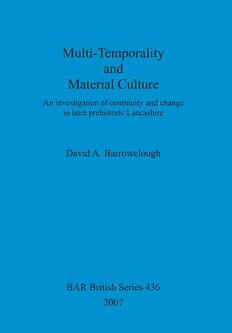Download Multi-Temporality and Material Culture: An investigation of continuity and change in later prehistoric Lancashire PDF Free - Full Version
Download Multi-Temporality and Material Culture: An investigation of continuity and change in later prehistoric Lancashire by David A. Barrowclough in PDF format completely FREE. No registration required, no payment needed. Get instant access to this valuable resource on PDFdrive.to!
About Multi-Temporality and Material Culture: An investigation of continuity and change in later prehistoric Lancashire
The study investigates why the scientific construction of knowledge about the prehistoric inhabitants of Lancastria has focused so much on individual artefacts and single sites removed from their landscape context. It asks why the knowledge and understanding assembled by archaeologists has had so little to do with studies of change over the long term. It examines some of the circumstances that shaped these approaches over the past 400 years tracing the parting of the ways between scientific and popular knowledge of the past. Specific research objectives of the study are to recontextualise the interrelationships between objects, monuments and landscape to facilitate a diachronic study of change in later prehistoric Lancastria; to explore the influence of local and regional contexts on strategies of exploitation, interaction, connectivity and interdependence amongst the prehistoric inhabitants of the region; to explore the changing role of technology and material culture in ordering and representing changing social identity; and to develop a model for the social reproduction of small-scale society through time within the region.
Detailed Information
| Author: | David A. Barrowclough |
|---|---|
| Publication Year: | 2007 |
| ISBN: | 9781407320915 |
| Pages: | 159 |
| Language: | English |
| File Size: | 17.031 |
| Format: | |
| Price: | FREE |
Safe & Secure Download - No registration required
Why Choose PDFdrive for Your Free Multi-Temporality and Material Culture: An investigation of continuity and change in later prehistoric Lancashire Download?
- 100% Free: No hidden fees or subscriptions required for one book every day.
- No Registration: Immediate access is available without creating accounts for one book every day.
- Safe and Secure: Clean downloads without malware or viruses
- Multiple Formats: PDF, MOBI, Mpub,... optimized for all devices
- Educational Resource: Supporting knowledge sharing and learning
Frequently Asked Questions
Is it really free to download Multi-Temporality and Material Culture: An investigation of continuity and change in later prehistoric Lancashire PDF?
Yes, on https://PDFdrive.to you can download Multi-Temporality and Material Culture: An investigation of continuity and change in later prehistoric Lancashire by David A. Barrowclough completely free. We don't require any payment, subscription, or registration to access this PDF file. For 3 books every day.
How can I read Multi-Temporality and Material Culture: An investigation of continuity and change in later prehistoric Lancashire on my mobile device?
After downloading Multi-Temporality and Material Culture: An investigation of continuity and change in later prehistoric Lancashire PDF, you can open it with any PDF reader app on your phone or tablet. We recommend using Adobe Acrobat Reader, Apple Books, or Google Play Books for the best reading experience.
Is this the full version of Multi-Temporality and Material Culture: An investigation of continuity and change in later prehistoric Lancashire?
Yes, this is the complete PDF version of Multi-Temporality and Material Culture: An investigation of continuity and change in later prehistoric Lancashire by David A. Barrowclough. You will be able to read the entire content as in the printed version without missing any pages.
Is it legal to download Multi-Temporality and Material Culture: An investigation of continuity and change in later prehistoric Lancashire PDF for free?
https://PDFdrive.to provides links to free educational resources available online. We do not store any files on our servers. Please be aware of copyright laws in your country before downloading.
The materials shared are intended for research, educational, and personal use in accordance with fair use principles.

